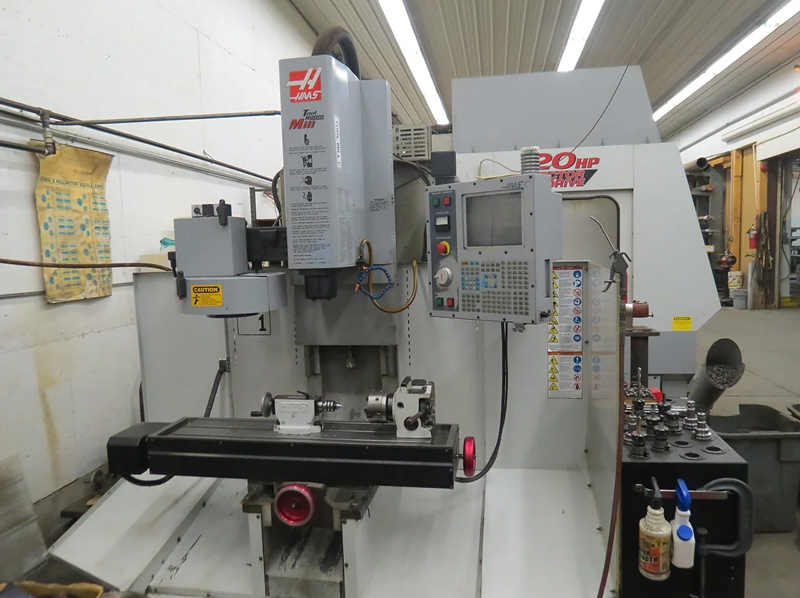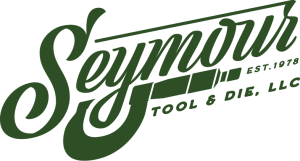A Computer Numerical Control (CNC) milling machine tool is used to remove material from a workpiece using rotary cutters. This process, known as milling, is essential in manufacturing processes for creating custom CNC parts with precise dimensions and complex shapes. The CNC machine is made up of several key components, including a base, column, spindle, worktable, and tooling.
Precision machining CNC is widely used in industries such as aerospace, automotive, electronics, and medical device manufacturing. It offers high precision and the ability to produce shapes that are difficult or impossible to achieve with manual machining methods.
Searching for CNC machining services in North East, PA? Our CNC machine shop offers both standard and custom CNC milling services to meet your needs.
Vertical Machining Centers
Vertical machining centers (VMCs) are essential in the manufacturing industry, known for their precision and versatility in machining complex parts.
HAAS Tool Room Mill (3)
- Maximum Load Capacity: 1000 lbs
- X-Axis 30 in (762 mm)
- Y-Axis 12 in (305 mm)
- Z-Axis 16 in (406 mm)
Each unit is equipped with a small rotary table, allowing it to perform multi-axis machining operations. This makes the HAAS Tool Room ideal for small to medium-sized parts requiring high precision.
HAAS VF-6
- Maximum Load Capacity: 4000 lbs
- X-Axis 64 in (1626 mm)
- Y-Axis: 32 in (813 mm)
- Z-Axis: 30 in (762 mm)
This model comes with a 12-inch rotary table, allowing for complex machining tasks that require rotational movement. The VF-6 is suitable for larger workpieces and offers substantial travel dimensions, making it versatile for a wide range of applications.
HAAS VF-3
- Maximum Load Capacity: 3500 lbs
- X-Axis: 40 in (1016 mm)
- Y-Axis: 20 in (508 mm)
- Z-Axis: 25 in (635 mm)
The VF-3 is designed to handle medium to large workpieces with precision. Its robust construction and travel dimensions make it a reliable choice for various machining tasks.

Horizontal Machining Centers
Horizontal machining centers (HMCs) are known for their ability to handle heavy-duty machining tasks with high precision and efficiency.
HAAS HS-1R
- Maximum Load Capacity: 1000 lbs
- X-Axis: 24 in (610 mm)
- Y-Axis: 20 in (508 mm)
- Z-Axis: 22 in (559 mm)
The HS-1R is perfect for small to medium-sized parts that require complex geometries. It is equipped with a 20-inch square rotary table to perform multi-axis machining operations.
HAAS EC1600 (50 taper spindle)
- Maximum Load Capacity: 10,000 lbs
- X-Axis: 64 in (1626 mm)
- Y-Axis: 40 in (1016 mm)
- Z-Axis: 32 in (813 mm)
The EC1600 has a 30-inch rotary table and a 50-taper spindle, making it suitable for heavy-duty machining tasks. A higher load capacity and travel dimensions allow it to handle large workpieces with ease.
Fryer HR-40
- X-Axis: 40 in (1016 mm)
- Y-Axis: 29 in (736 mm)
- Z-Axis: 25 in (635 mm)
This model is equipped with a 24-inch rotary axis, providing the flexibility to perform complex machining operations. The HR-40 is designed to handle medium to large workpieces with precision.

How CNC MACHINING Works
The process begins with a detailed design of the part using Computer-Aided Design (CAD) software. This design is then converted into a program using Computer-Aided Manufacturing (CAM) software, specifying tool paths and cutting parameters. A CNC machinist sets up the machine by securing the workpiece on the worktable, installing the appropriate cutting tools, and calibrating the machine for accuracy.
The CNC machine autonomously follows the code instructions, executing the cuts with high precision and repeatability. Machinists monitor the process (making adjustments if necessary) and remove the finished part once the machining is complete. The part may undergo additional processes like cleaning, inspection, and finishing to meet quality standards.
View All Precision Machining Services
Frequently Asked Questions
How do you know whether to choose a horizontal or vertical CNC milling machine? What materials can a CNC machine mill? What are the most common applications for CNC milling machines? When should you choose a CNC milling machine over a manual engine lathe? What do you need to provide the milling machine with to start the machining process? What is CNC Milling? What is the typical lead time for CNC milling? What quality control measures do you have in place?CNC Milling
Contact Seymour Tool & Die
Interested in our precision machining services? Contact our skilled machinists today with any questions, comments, or suggestions about your job and what we can do for you.
 11416 Wilson Road., North East PA
11416 Wilson Road., North East PA 
